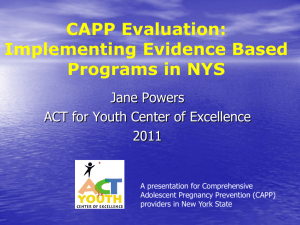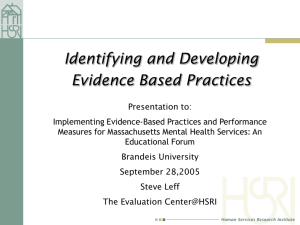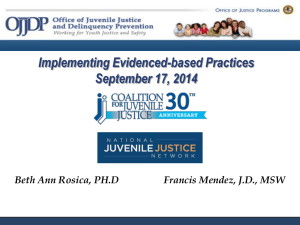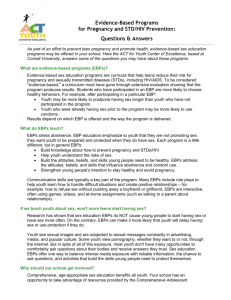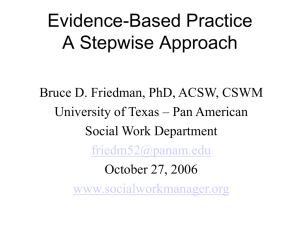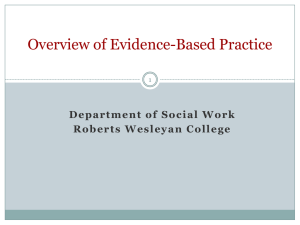CDC Division
advertisement
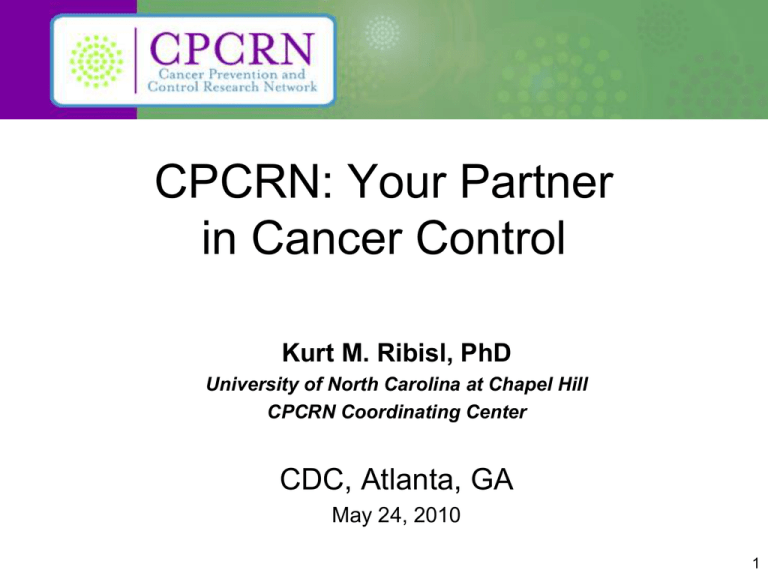
CPCRN: Your Partner in Cancer Control Kurt M. Ribisl, PhD University of North Carolina at Chapel Hill CPCRN Coordinating Center CDC, Atlanta, GA May 24, 2010 1 CPCRN Mission To accelerate the adoption of evidence- based cancer prevention and control in communities. 2 Organization • One of five Thematic Research Networks in the Prevention Research Centers (PRCs) – Only Thematic Network focused on dissemination and translation • Collaboration with two Federal Agencies – CDC – Division of Cancer Prevention and Control – NCI – Division of Cancer Control and Population Sciences • Ten Network Centers at major research institutions 3 PI’s Michelle Kegler, DrPH Jennifer Allen, ScD, MPH, RN Marcia Ory, PhD, MPH Betsy Risendahl, PhD Roshan Bastani, PhD James Hebert, ScD, MSPH Cathy Melvin, PhD Kurt Ribisl, PhD (Coord Ctr) Maria Fernandez, PhD Vicky Taylor, MD, MPH Matthew Kreuter, PhD, MPH 4 Network Center Map 5 Selected Projects 1. 2. 3. 4. 5. 6. 7. 2-1-1 to Reduce Disparities HPV Vaccination Use of Evidence-Based Practice Cancer Registry Data BCCEDP CRC Control Programs FQHC Research 6 • 240 active systems • 46 states, DC, Puerto Rico • 80% of U.S. population • 14.3 million calls in 2008 7 Survey administered in four 2-1-1 systems Goal (~300 surveys/Center) 8 Assessing six cancer control actions Mammography Pap testing Colonoscopy HPV vaccination Smoking Smoke-free home policies 9 2-1-1 callers vs. U.S. population - 2-1-1 callers (n = 1,413) - 2008 BRFSS (n = 415,194) 10 Unmet Needs Cancer needs of 2-1-1 callers (n=1,413) - Need at least one action 72% - Need two or more 42% - Need three or more 17% 11 Risk Factors 2-1-1 Callers vs. BRFSS Risk factor/ preventive measure 211 Respondents (n) 2-1-1*, % BRFSS U.S, % p No health insurance All (n=1408) 37.2 15.2 <.0001 Current cigarette smoker All (n=1408) 39.6 18.4 <.0001 Has smoke-free policy All (n=1408) 69.4 76.4 <.0001 Ever had a colonoscopy 50.2 61.4 <.0001 19.4 18.4 <.0001 Received HPV vaccination (daughter) Men and women, 50+ (n=337) Women, 18-26 (n=229) Have daughters 9-17, (n=271) 35.9 na Up-to-date on mammography Women, 40+ (n=529) 56.5 76.3 <.0001 Up-to-date on Pap smear, last yr Women, 18+ (n=1128) 53.5 57.8 <.0001 Received HPV vaccination (self) * Adjusted for gender and age 12 Information and Referral… Mammograms Pap smears Colonoscopies HPV vaccination girls 9-17 Merck Patient Assistance Program Smoking cessation Smoke-free home policy 13 HPV Projects • HPV Policy Analysis – Started in 2008 – Participants from UCLA, UNC, UT, UW, & CDC – Produced a detailed database of state legislative bills nationwide re: vax from 1/06-6/08 – Will help guide development of future policies – Manuscript in preparation 14 HPV Projects • HPV Measures Review – Started in 2007, let by Jennifer Allen (Harvard) – Participants from Harvard, Emory, Morehouse, UCLA, UNC, UT, UW, & CDC – Conducted a lit review of surveys re: knowledge, attitudes, behaviors related to HPV vaccination – Provided important info re: quality of existing measures – Manuscript in press at Vaccine 15 HPV Projects • HPV Cognitive Testing – Participants from UNC, Harvard, UCLA, UT, UW, WU, NCI, & CDC – 57 cognitive interviews conducted to cog test 20 survey items for parents/caregivers of vax-eligible girls – 13 items revised based on findings – Produced a set of validated survey items for use in CPCRN HPV survey and others – Led by Alice Richman/Noel Brewer (UNC-CH) 16 HPV Projects • HPV Latino Survey – Participants from UCLA, Harvard, UT, UW, WU, & CDC – Bilingual survey with 24 core items targeted @ parents/ caregivers of vax-eligible girls (917) – Administered in multiple settings – Builds on lessons learned from Measures and Cog Testing projects 17 Promoting EvidenceBased Practice • National and Statewide Trainings • Research and Partnerships with Cancer Control Planners 18 Designing Prevention Programs that Work Training Topics Important Concepts What do we mean by evidence-based? • Define evidence-based (EB) • Continuum of evidence • Benefits of using EB strategies/programs Needs assessment & program planning • Community and target audience analysis • Determinants of behavior Finding an evidence-based strategy or program • Sources of EB strategies & programs • Selecting a strategy or program (“fit”) Adapting the evidenced-based program to meet your needs • Define: adaptation, core elements, fidelity • Discuss what can & cannot be changed Evaluating your program • Process evaluation (e.g., implementation, fidelity, program adaptations) • Outcome evaluation 19 History of Trainings (Coming June 2010 to This Center) Audience Reach Health educators – Georgia Federation of Professional Health Educators – A SOPHE Chapter 102 SW GA Mini Grant applicants: Community-based organizations 35 National Breast and Cervical Cancer Early Detection Program (NBCCEDP)/CDC (2 parts) Recruitment & professional development coordinators 116 Comprehensive Cancer Control Program Directors 120 National Association of Chronic Disease Directors 28 REACH US Grant Applicants 62 20 CPCRN Partners’ Awareness & Use of EBPs and EBP Resources: EBP Resource Inventory Partner Survey Peggy Hannon et al. (U Washington) 21 Purpose • Funders increasingly seek evidence-based approaches and programs (EBPs) • Many program planners have limited training for finding and using EBPs • CPCRN seeks to create a training framework and interactive tool to facilitate cancer control planners’ use of EBPs 22 Key Questions • Do community-based cancer control planners use EBPs? – Do planners want to use EBPs? – What resources are available to support EBP use? – Are planners aware of and using these resources? • What training and support is needed to enhance use of EBPs? 23 EBP Resources Inventory • Web-based resources – Cancer Control P.L.A.N.E.T – Guide to Community Preventive Services – Research-Tested Intervention Programs • In-person training program – Using What Works 24 Pilot Survey: CDC Cancer Conference, 2007 • 63 participated in interactive survey w/ hand-held devices • Use of resources varies – 35% (R-TIPs) – 72% (P.L.A.N.E.T.) • Most find using EBPs challenging – 32% agree EBPs easy to find & obtain – 24% agree EBPs easy to adapt 25 Partner Survey • Each CPCRN Center surveyed > 30 partners • Key survey domains – – – – Source of their programs Perceptions of EBPs Use of EBP resources Perceived EBP training needs • 240 respondents included in analyses 26 Partners’ Program Sources Developed Own Program 69 Used Existing Program 68 Adapted Existing Program 69 0 20 40 60 80 100 % Doing Activity in Past Year 27 Awareness & Use of EBP Resources 43 Guide 28 49 P.L.A.N.E.T. 36 Ever heard of Ever used 22 R-TIPs 13 Any of the above 65 48 0 20 40 60 80 Percent Note. 80-85% of those who had ever used these resources rated them as somewhat or very useful 28 EBP Resource Use & EBP Beliefs Never Used Resources Used Resources Our funding agency encourages us to use EBPs* I know where to find EBPs* EBPs are easy to implement EBPs are easy for us to adapt 1 Note. * indicates p < .01 1.5 2 2.5 3 3.5 4 Agreement w/ Statement (5= Strongly Agree) 4.5 5 29 Partners’ Training Needs Find resources 76 Adapt for cultural appropriateness 64 Develop imp. Plan 63 Assess resources 62 Obtain program materials 60 ID core elements 59 Implement and evaluate 55 Pilot test program 51 Involve partners 50 Recruit participants 46 0 20 40 60 80 100 30 Conclusion • Cancer control planners know and like “evidence based” • Majority are not using EBP resources • Majority report significant training needs to support EBP use Hannon PA, Fernandez ME, Williams R et al. Cancer control planners’ perceptions and use of evidence-based programs. J Public Health Manag Pract, in press. 31 Novel use of Registry Data in SC Hebert JR, Daguise VG, Hurley DM, Wilkerson RC, Mosley C, Adams SA, Puett R, Burch JB, Steck SE, Bolick-Aldrich Sl. Mapping cancer mortality-to-incidence ratios to illustrate racial and gender disparities in a high-risk population. Cancer 2009;115:2539-52. 32 PrCA Incidence in Relation to Soil Metal Concentration: Unique Use of Combining SCCCR & Environmental Data Selenium Zinc Legend PrCA and Soil Overlay Categories Low SIR and High Concentration Middle Levels High SIR and Low Concention No data Wagner SE, Burch JB, Hussey J, Temples T, Bolick-Aldrich S, Mosley C, Liu Y, Hebert JR. Soil zinc content, groundwater usage, and prostate cancer incidence in South Carolina. Cancer Causes Control 2009;20:345-53. • Texas Cancer Information – Texas Cancer Information can connect patients, caregivers, the general public, health care policy planners, physicians and other health professionals with reliable online cancer information. – Dr. Fernandez is on the advisory committee. – Dr. Fernandez is working with Lewis Foxhall on developing a logic model for the TCI. 34 Promoting Screening • All Centers have projects – Promoting cancer screening – Have linkages with the Comprehensive Cancer Program • Promotion of screening through kiosks – Washington University (Matt Kreuter et al.) • Survey of BCCEDP – Emory University (Escoffery and CPCRN) 35 36 Reach and specificity Criteria for prioritizing among settings Highest reach Laundromats • Health centers • Lowest specificity Public libraries • Social services • • Churches • Beauty salons Lowest reach Source: Kreuter et al. Highest specificity Using technology to connect rarely and never screened women to mammography • kiosks equipped with telephones and wireless technology •placed in Laundromats and public libraries to reach high volumes of rarely or never screened women •kiosk-administered survey identifies women needing mammograms •instant connection to nearby, free mammography programs directly from the kiosk 38 Inventory and Assessment of National Breast and Cervical Cancer Early Detection Program • PI: Cam Escoffery, PhD (Emory) • CPCRN Participating Centers-Advisory Committee: – Emory (Glanz, Kegler) – Harvard (Sorenson) – Morehouse (Blumenthal) – SLU/Washington University (Kreuter) – UCLA (Bastani) – UNC (Porterfield) – UT (Fernandez, Mullen) – UW (Harris, Taylor) • Funder: CDC 39 Purpose of Study • Inventory NBCCEDP interventions used to recruit women for screening and interventions used for the professional development of program staff and healthcare providers • Assess the recruitment and professional development interventions used based on their application of evidence-based cancer prevention practices • Disseminate the findings to encourage effective, evidence-based interventions for recruiting women and the professional development of healthcare providers 40 Research Questions • What is the use of evidence-based resources for increasing cancer screening by NBCCEDP grantees (i.e., Community Guide, RTIPS)? • To what extent do the recruitment and professional development activities match evidence-based interventions to increase breast and cervical cancer screening? • To what extent do NBCCEDP grantees implement process steps or core elements from evidence-based interventions for their recruitment and professional development activities? (intervention fidelity) • What are interventions perceived to be effective by the NBCCEDP? (practice-based evidence) 41 Promoting CRC Screening 42 Goal Help community organizations create effective information resources for populations they serve Approach Make it easy to design and customize high quality, audience tested information resources 43 ` 44 44 45 45 St. Louis Kansas City El Paso Lower Rio Grande Valley Red-Controls 46 Calls to 1-800-4-CANCER (group*time interaction, F=8.6, p=.004) - St. Louis - LRGV Calls to CIS - Kansas City - El Paso Pre-MIYO MIYO 47 47 About CRCCP • 80% screening by 2014 • Using EBIs from the Guide • client reminders • small media • reducing structural barriers • provider assessment/feedback • provider reminders • 26 states & tribal orgs 48 49 49 Survey of NCCCP grantees 1. Do you have CRC resources targeted to… - patients? - spouses/partners? - children of eligible adults? - health care providers? - community health centers? - community organizations? 2. How satisfied are you with… - the number of resources you have? - the quality of resources you have? 50 Survey of NCCCP grantees 3. Are any resources further targeted by… - rural-urban? - SES? - race or ethnicity? - sex? 4. What is your highest priority population? 5. What EBIs and resources interest you most? 51 Responses to date - Web-based survey - Program leaders and community partners - 18 of 26 programs responded to date (69%) - 77 of 180 invitees responded to date (43%) 52 New Cross-Center Project CPCRN Survey of Colorectal Cancer Control Programs (CRCCP) Proposal • Survey CRCCPs to assess Dissemination and Implementation (D&I) activity • Identify precursors of D & I success • Identify challenges to D & I • Monitor progress over time 53 A unique opportunity for CPCRN • Natural laboratory for dissemination • Defined set of cancer control EBIs • Large-scale practice settings • Perfect timing 54 Survey of Federally Qualified Health Centers • Sample: FQHC in Network states belonging to their state primary health care association. • Focus on organizational factors that influence implementation of evidence-based breast, cervical, and colorectal cancer screening interventions in primary care practice. • The project would provide information about translation processes in health center settings. • We would be able to include multiple geographic areas and health centers serving diverse patient populations. 55 FQHC Centers • • • • • • • • • California Colorado Georgia Massachusetts Missouri North Carolina South Carolina Texas 110 14 28 24 21 27 22 58 Washington 25 Network members in states with smaller numbers of health centers could survey all of the health centers in their state, and Network members in states with larger numbers of health centers could randomly select a sample of health centers. 56 FQHC Survey Research Topics Predictors of Adoption of Cancer Control interventions Organizational characteristics Innovation-specific infrastructure General infrastructure Organizational readiness to adopt Leadership and decision making characteristics Leadership stability (over time) Centralized vs. decentralized decision making process Network characteristics Professional network How connected to others? To whom are they connected? Formal affiliations Sources of information for program/strategy planning or selection EBI characteristics 57 CPCRN Strengths • Advancing science for implementation and translation research • Strong community partnerships • Focus on underserved populations • Broad geographic outreach • Research focus that complements CDC priorities • Infrastructure funding provides impetus to focus beyond discovery and be opportunistic 58 Contact Us • CDC Contacts – Kathi Wilson – Vicki Benard • UNC Coordinating Center – Kurt M. Ribisl – (919) 843-8042; kurt_ribisl@unc.udu • Contact Centers Directly on Specific Projects – please cc: Kurt/Kathi/Vicki 59
